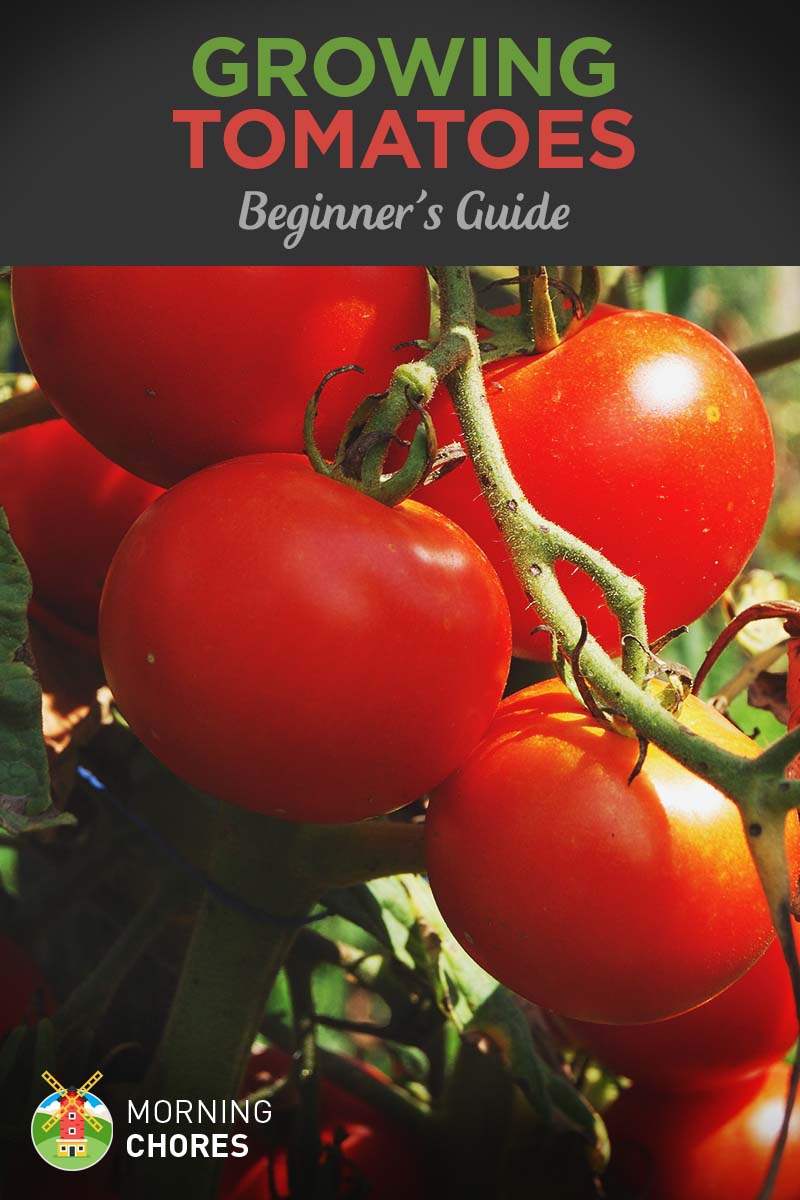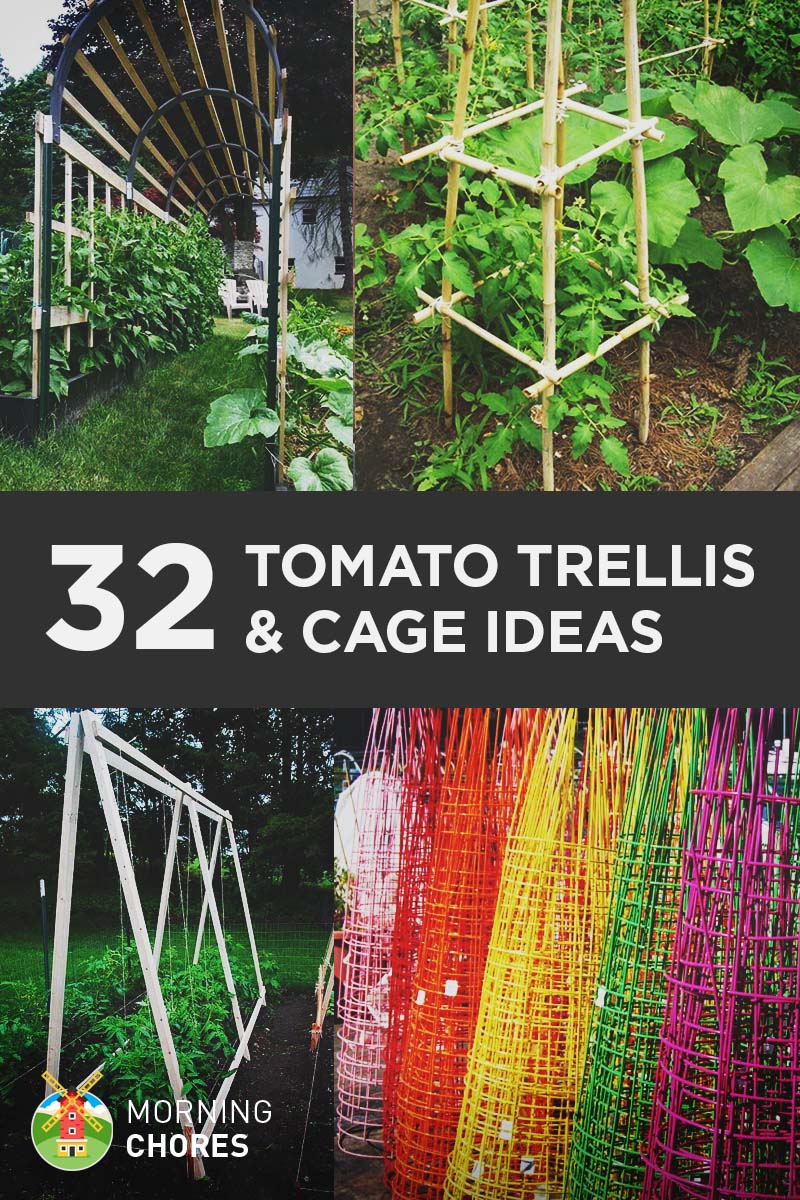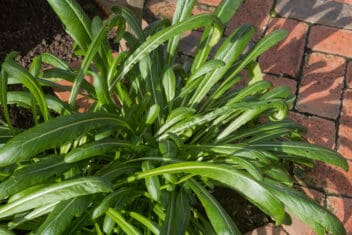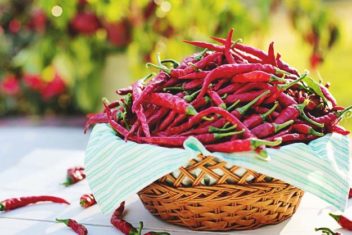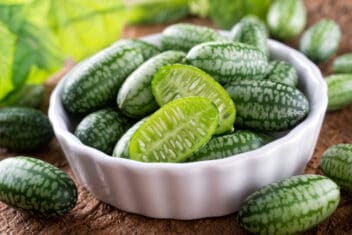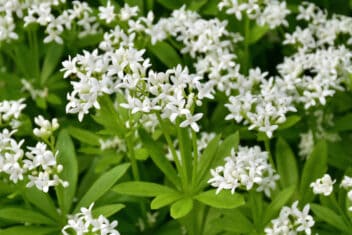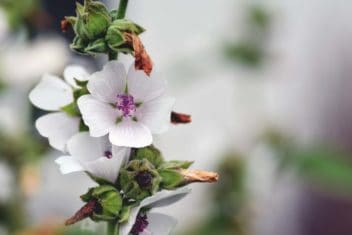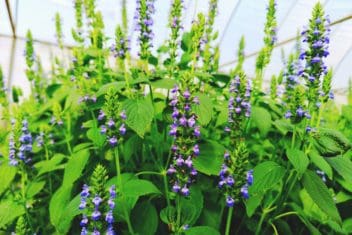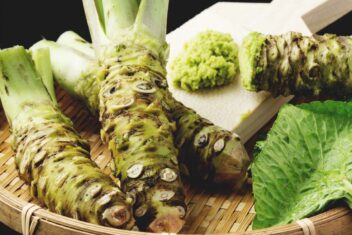A homegrown tomato is a revelation. If you have a friend who says they hate tomatoes, try giving them one still sun-warmed that has been growing in your garden. Chances are, they’ll change their tune.
However, as tasty as they are, tomatoes often come with some problems. They can be fussy plants that you have to treat right if you want a bountiful harvest.
The key to a happy tomato garden is choosing the right varieties, giving them a solid foundation, and knowing how to care for them. If trouble comes, this article will also help you figure out how to deal with it.
Best Tomato Varieties
Picking the right tomato can feel downright overwhelming at times. There are so many varieties to choose from.
There are seven main types, each with dozens of varieties. They include cherry, beefsteak, grape, cocktail, Roma, green, or heirloom. You can read more about the different types in our guide to get a better idea of each.

That isn’t even all of them. There are other less popular varieties as well, including paste, yellow, and pear tomatoes.
With all the options out there, how do you pick the right one? Here’s what to look for:
Disease Resistance
The first thing to consider is the plant’s resistance to disease. Check the label of the plant or seed packet. Right next to the name of the plant, you’ll see a letter in parenthesis.
Diseases like verticillium will have a V in parenthesis, which means that the plant is resistant to verticillium wilt. Other common diseases you will see on the packaging are Fusarium wilt (F); Root-knot Nematode (N); Tobacco Mosaic Virus (T); and Alternaria (A).
I recommend doing a little research` to see what soil-based diseases are most common in your area and choose varieties that are resistant to them. That way, you’ll have fewer headaches this growing season.
Determinate vs. Indeterminate
There are two types of growth patterns in tomatoes. The first is determinate growth. Determinate means that the plant grows to a set height and width, flowers, and then spends its time ripening the fruit.
If you’re planning on growing tomatoes in planters, then determinate varieties are a smart option.
An indeterminate variety is one where the plant continues to grow all season up until frost, at which point it dies. Since these varieties never stop spreading taller and wider, they require staking and cages to help support them.
Growing Time
The third thing you should take into account when picking a tomato variety is the time it takes for the fruit to mature. Some tomato plants – like Fourth of July – have growing seasons as short as 50 days.
If you live in the north where summer can be a little late and winter can sneak up early, then you might need to choose one of these varieties so you can get the maximum amount of fruit from your plants.
However, if you live in the south (like me), then you have a longer growing season. You can plant a tomato that takes up to 90 days to start producing, like beefsteak tomatoes.
Fruit Characteristics
Finally, the last thing you need to take into consideration when choosing your tomato variety is the fruit characteristics. How big will the fruit get? What will it taste like?
If you’re looking to grow tomatoes for sandwiches, then you won’t want cherry tomatoes. However, if you are looking to make a sauce or salsa, then a Roma or cherry tomato might work just fine for you.
For instance, I love to grow persimmon tomatoes to make yellow tomato sauce. It not only tastes good but it looks gorgeous in a jar, too.
Planting Tomatoes
We have a large garden and usually grow about 2-3 flats of tomatoes. If you’re looking to have a few tomatoes on hand for sandwiches, then you shouldn’t need more than 2-3 plants. But if you’re looking to preserve tomatoes or make sauces, then you might want to grow more.
Growing Zones
Tomatoes grow in zones 2-10.
Sun Requirements
Tomatoes require full sun, with more than 6 hours per day in the northern regions.
Soil Requirements
Tomatoes like rich, well-draining, loamy soil with a pH between 6.0 and 6.8.
Starting from Seed
Start seeds indoors 6 to 8 weeks before the last frost date. You can use this seed-starting calculator to know exactly when you should begin growing your seeds for your location.
Seed starting containers make the job easier. You can use seed trays or foil lasagna trays with holes poked in the bottom. The seed starting trays make things a little easier, but I also understand what it means to grow your food on a tight budget, so the foil trays work too.
Place a solid tray under the flat of seeds because this is how you’ll water them. If you purchase grow trays, they usually come as part of the set-up. If not, use a large foil tray instead.
Use a tomato-specific seed starting mix like that from FoxFarm to fill your trays. Drop 1-2 seeds in each cell of the tray – or every few inches in a lasagna tray – and gently cover them up.
Sprinkle cinnamon lightly over the soil. It helps deter fungus that likes to grow on top of the soil and can harm seedlings.
Place the flat of seeds on a solid tray under grow lights. I prefer shop lights because they work the same but are much cheaper to buy and run.
Never water seeds from the top during the germination process. Add water to the trays and allow the seeds to soak it up from the bottom. Mist the seeds with a spray bottle to keep them moist.
You know the seeds are ready for water when the tray underneath them is dry. That way, you never risk overwatering your seedlings.
Transplanting
Harden seedlings off for at least two weeks before planting. You can do this in a greenhouse or you can move them outside for longer periods of time each day.
Transplant them after the last frost date, when the soil is warm, and the seedlings are 3 to 4 inches tall.
Spacing
Give 2 feet between each plant and each row. Plant transplants 8-12 inches deep.
Caring for Your Tomatoes
Starting tomatoes is the easy part. After you’ve planted them, the challenge begins.
First, keep dirt off of the stems of the tomatoes. By keeping their stems clean, you are lessening their chance at picking up diseases.
Watering
Water generously, at least 2 inches per week during the summer.
Because tomatoes are disease-prone, it’s vital to water from the ground and avoid overhead irrigation. You can use soaker hoses to water your plants effectively.
Fertilizing
Give tomatoes a weekly feed with a liquid tomato fertilizer.
Staking
If you’re growing indeterminate varieties, you’ll need to stake or cage your tomatoes to support them and keep the fruit off of the ground.
Staking is key to avoiding disease and to maximizing your harvest. Check out our guide for a bunch of unique tomato cage and trellis ideas that will add a little character to your garden.
Extra Tips On Growing Tomatoes
Some gardeners like to add a teaspoon of Epsom salt to the base of each plant because they say it makes the tomatoes taste sweeter.
I personally prefer the acidity of the tomato, so I don’t want it to be super sweet, so I don’t do this. But I know many people that do, and they claim it works. You can always experiment in your garden and see what works for you.
Problems and Solutions to Growing Tomatoes
When growing tomatoes, the biggest issue are the numerous diseases and pests that bother them.
Don’t be deterred. Most tomato issues are fixable by using ground irrigation, giving proper nutrition, and keeping the fruit and parts of the plant off of the ground.
To keep bugs away, we planted marigolds or onion starts next to each tomato plant. I also use natural repellents, and I keep guinea fowl.
I have to say, keeping guinea fowl has honestly been the best investment we have ever made in our garden. They cost little to raise and add such humor to our farm.
Aphids
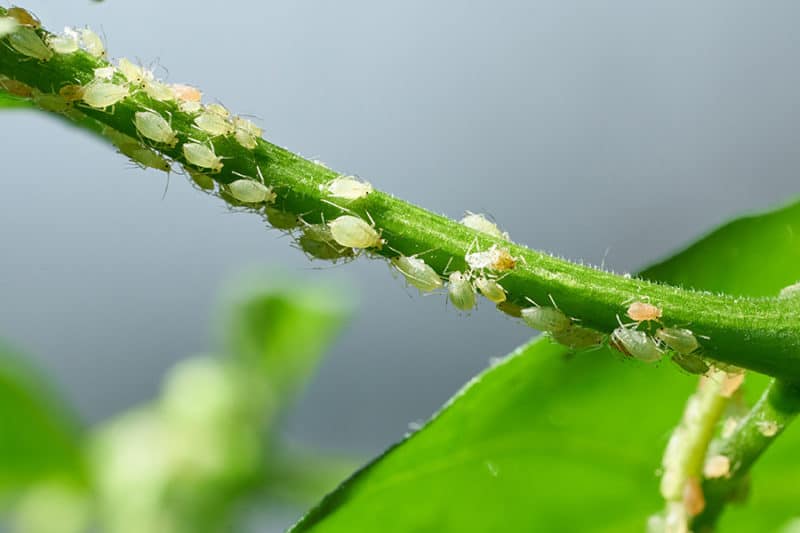
Aphids love tomatoes. You can tackle them with insecticides. If you prefer to stick with a more natural route, you can make your own organic bug repellent. We also have a whole guide dedicated to dealing with these little pests.
Flea Beetles

Flea beetles are tiny little beetles that hop around like fleas, which is where they get their name. Not only can they chew through leaves and stunt growth, but they spread disease as well.
Get rid of them using neem oil or insecticides. You can also sprinkle diatomaceous earth around your tomatoes and put sticky traps throughout the garden.
Prevent them using row covers and by encouraging beneficial nematodes.
Tomato Hornworm
Sooner or later, almost every tomato grower deals with these green menaces. They’re voracious eaters and one hornworm moth can have multiple generations each year.
The caterpillars are about 5-inches long with a horn-like growth on their rear end.
Start by handpicking them off your plants and feed them to your chickens or drown them in soapy water. If that doesn’t work, use the organic pesticide Bt.
Blossom End Rot
We have this every year in my garden, so I’ve learned lots of tricks for dealing with it.
As it ripens, the fruit turns back on the bottom and begins to rot from the bottom up. It’s difficult to save any fruit that has blossom end rot.
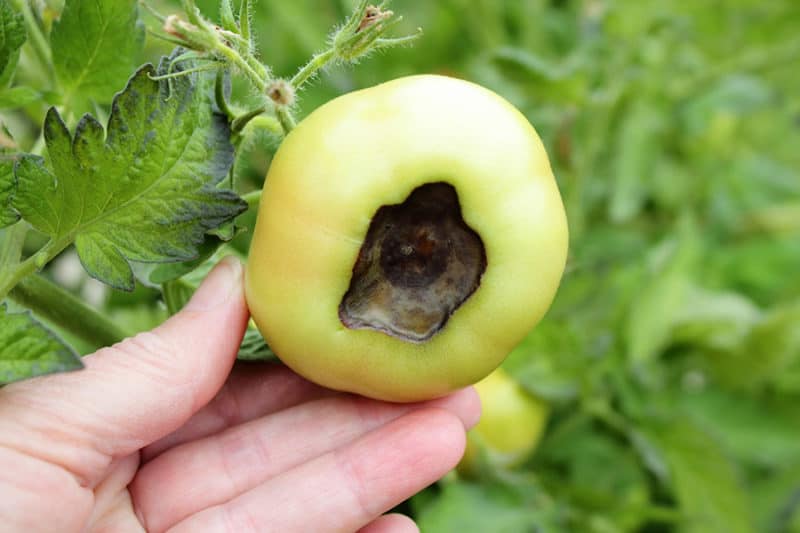
The best way to fix this problem is to make sure you fertilize about once a month. Strike the right balance between nitrogen and calcium when fertilizing.
Also, providing even soil moisture seems to play a large role in things as well. We’ve switched to soaker hoses and so far are seeing great results.
Add 1 tablespoon of powdered milk to the base of each plant during the early part of the season before this problem develops – kind of like vaccination for tomatoes.
Tobacco Mosaic Virus
You know you have this when your tomatoes become yellow and green spotted. They may develop brown patches on them as well. Leaves will develop a lighter green mottled pattern. There’s no cure, so prevention is best.
Clean your hands and tools between plants when working in the garden. Keep your garden weed free and rotate your crops each year. Remove and discard any infected plants.
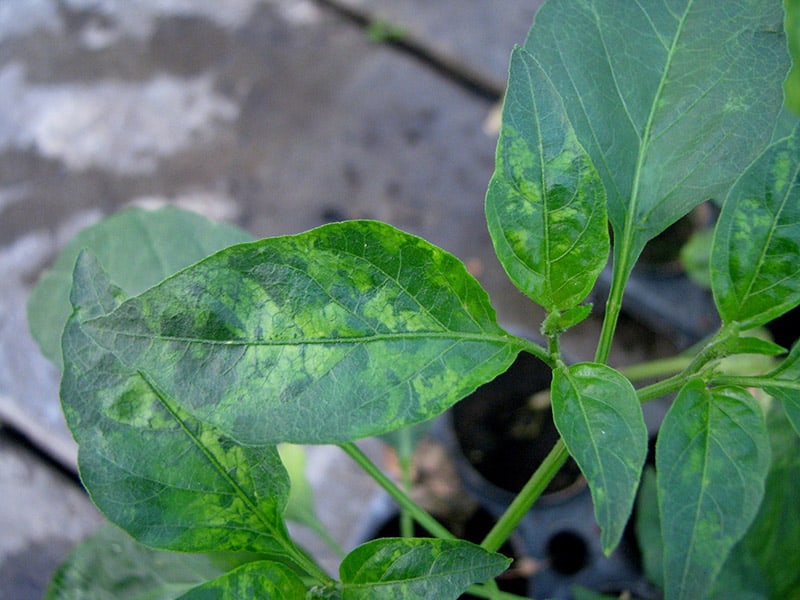
If you’re a smoker, be sure to wash your hands thoroughly before touching your tomato plants and don’t carry tobacco products into the garden.
Also, be sure not to plant where any infected tomato or tobacco plants were planted previously. Bugs can carry this disease, so keep them at bay. I recommend looking for a variety of tomato that is resistant to this disease, as well.
Radial Cracking
This is another disease we battle with most years. You know you have it when the top of the tomato begins to crack and split.
Some of the tomatoes are still salvageable, but it’s a pain nonetheless.
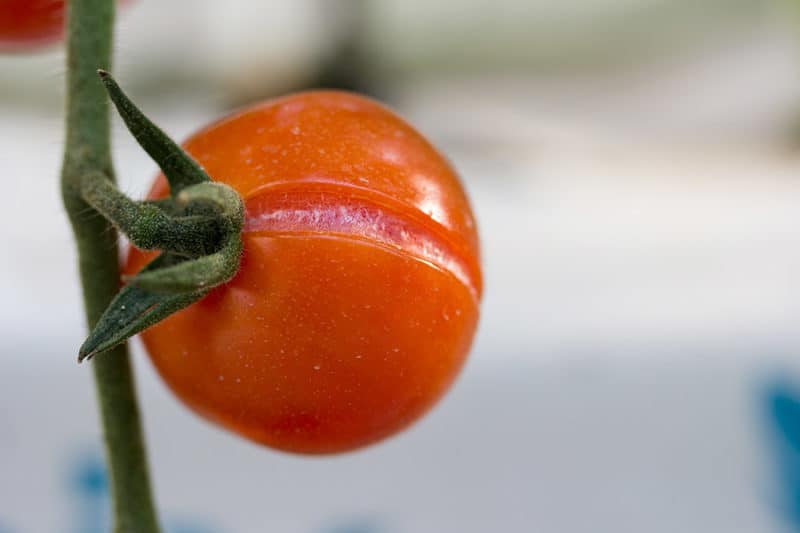
The best thing you can do is to select varieties that don’t suffer from this problem. The tough part about that is that some of the favorites are prone to this. I’ve found it common in most larger varieties.
You can also prevent this by avoiding large changes in moisture levels by using soaker irrigation and providing plenty of mulch around plants.
Sour Rot
Sour rot causes your tomatoes to crack and erupt with a white, scummy fungus. Yes, I’ve dealt with this one, too.
The best thing you can do is to not wet the surface of the tomatoes by watering at the base. Be sure to stake your tomatoes properly to keep the fruit off of the soil.
Verticillium Wilt
Verticillium causes older leaves on the tomato plant to turn yellow and brown. They’ll eventually wilt. This happens mainly during colder weather.
The only way to prevent this from happening is buying a variety of plant that is resistant to it.
Early Blight
If your tomatoes contract this disease, the fruit will appear with dark and leathery lesions on the skin near the stem.
Early blight can be prevented with fungicide spray and by rotating your crops.
Alternaria
Plants infected with Alternaria have gray sunken spots on them.
Be careful not to damage your plant when pruning. Also, water by ground irrigation instead of using sprinklers.
Root Knot
This disease is hard to stop because it starts underground. You’ll know you have this if you’re properly feeding your plants, but they still seem sluggish. Then, when you go to pull them up, you see that the root is literally tied in a knot and has multiple growths on it.
The best ways to prevent this are by proper crop rotation and also to plant tomatoes with a trap crop. A common trap crop is Elbon cereal rye. It helps limit nematode production.
The Best And Worst Companion Plants For Tomatoes
The best companion crops for tomatoes include:
- Borage
- Chive
- Marigold
- Nasturtium
- Basil
- Calendula
- Carrot
- Sage
- Onion
- Garlic
- Lettuce
- Asparagus
- Bean
- Cucumber
- Mint
- Parsley
- Nettle
Leaf lettuce is a great companion plant for tomatoes because it serves as a living mulch. You can plant leaf lettuce all between the tomatoes, and it will help hold moisture for the plants.
The worst companion crops for tomatoes are:
- Peppers
- Corn
- Potatoes
- Cabbage
- Cauliflower
- Broccoli
Planting pepper plants and tomatoes together is a big negative. The reason is cross-pollination. It will completely ruin the taste of your tomatoes. So be sure you always put a few rows between them if planting them in the same garden.
How To Properly Store Your Tomato Harvest
Knowing when to harvest and how to store your tomatoes is the final element to having a successful growing season.
I like to harvest tomatoes when they are red but not overly ripe unless I’m going to eat them immediately. The reason I like them to be not too ripe is that they will turn to mush by the time I’m ready to use them otherwise.
To harvest, pull them from the plant when you think they’re at the right stage of ripeness for your needs. If they are tough to remove, it could mean that they’re a little underripe. If they fall right off in your hand, they’re ready to eat right away.
Once you bring them into the house, wipe the dirt off of them. Then store them in a cool, dry, and dark location so they won’t ripen too fast or mold. I usually store mine on a corner kitchen shelf upside down.
I do this because a tomato is usually less ripe at the top than the bottom. Letting them rest where the stem used to be helps to stop the molding process of the tomato.
You can store your tomatoes in the fridge if you wish. I personally don’t like their taste after refrigeration, so I don’t. If you need to store them for longer than a few days then refrigeration is a great option.
If you’d like to cut up your tomatoes in advance, be sure only to cut what you’ll eat in less than a week’s time. Store them in airtight containers in the refrigerator.
Tomato Recipes For Your Homegrown Tomatoes
After you’ve put in all of the hard work of growing your tomatoes, it’s time to dig in. Here are some ideas on how to enjoy your harvest.
1. Tomato Sauce
Everyone knows fresh tomato sauce tastes excellent on pasta. Here is a fantastic tomato sauce recipe that will be sure to satisfy your taste buds.
2. Salsa
My family and I are salsa people. We love it! It’s great on eggs, to dip chips in, on top of burgers with melted cheese, and so much more. Here is a recipe that will show you how to make and can salsa.
3. Tomato Soup
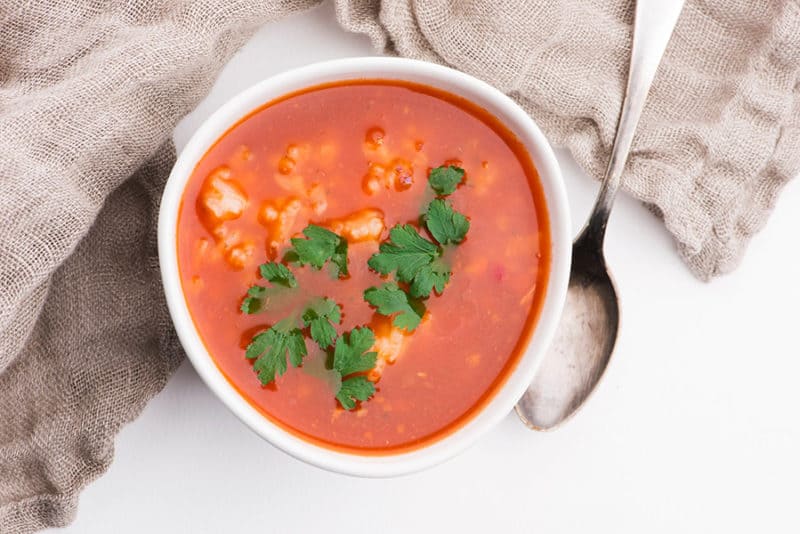
My kids love tomato soup. The only problem is, I don’t love the canned taste from the store-bought kind – nor do I love the preservatives. After making and canning your own tomato soup, you’ll never look back. You can’t beat that fresh tomato taste in the dead of winter.
4. Crushed Tomatoes
This is what I do with most of my tomato harvest. Why? Because I am a soup girl, especially in winter. I could live off of the stuff.
Crushed tomatoes go well in homemade chili, homemade vegetable soup, black bean soup, and my favorite, slow cooker chicken tortilla soup.
5. Tomato Juice
I am not a huge fan of tomato juice, but my husband is. He can open a jar and drink it in one sitting. So if you are like him, then you’ll love making your own homemade tomato juice.
For those that are like me, tomato juice is a nice addition to homemade soups, as well. This recipe will help you in the making and canning process.
Now You’re Ready to Start Growing Tomatoes
Tomatoes may not be the easiest crop in the garden, but it certainly one of the most rewarding. Whether you nibble on them fresh from the vine or use them to make soups in the dead of winter, tomatoes are a must-have. Be sure to tell us your favorite recipe and let us know if you have any tips.
